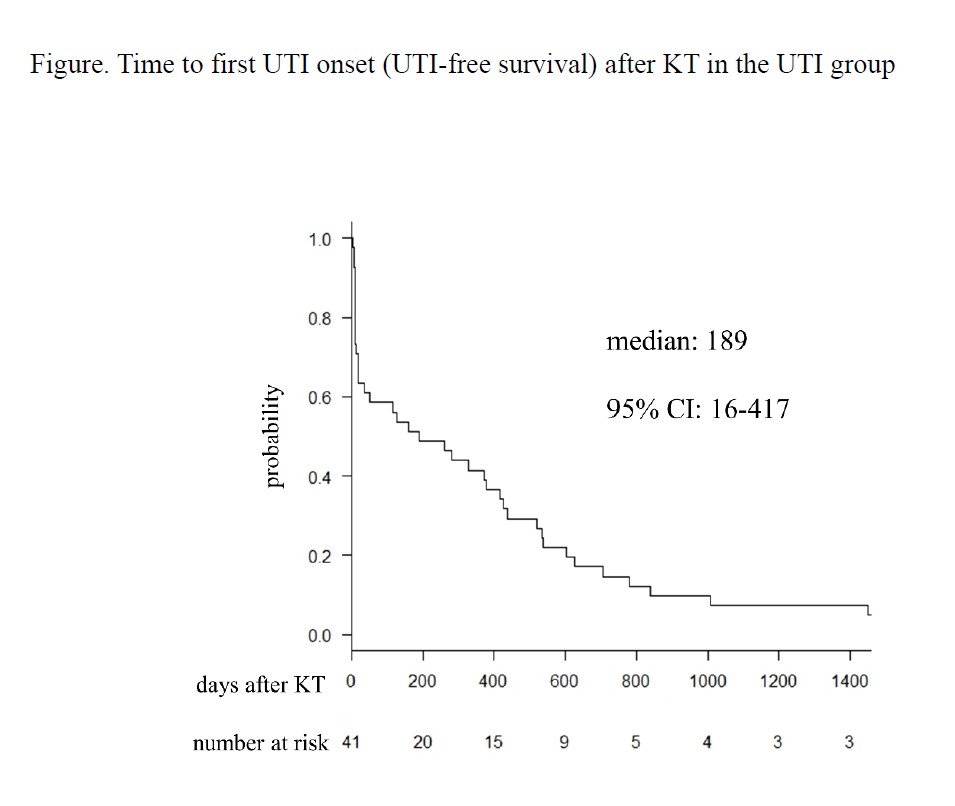Predictive Factors and Management of Urinary Tract Infections After Kidney Transplantation: A Retrospective Cohort Study
T. Shimizu, Y. Kinoshita, T. Shinzato, D. Iwami
Jichi Medical University, Shimotsuke City, Japan
Meeting: 2021 American Transplant Congress
Abstract number: 799
Keywords: Infection, Kidney transplantation, Risk factors
Topic: Clinical Science » Infectious Disease » Kidney Infectious Non-Polyoma & Non-Viral Hepatitis
Session Information
Session Name: Kidney Infectious Non-Polyoma & Non-Viral Hepatitis
Session Type: Poster Abstract
Session Date & Time: None. Available on demand.
Location: Virtual
*Purpose: Urinary tract infection (UTI) is one of the most common infectious complications in kidney transplant recipients. The predictive factors for UTI are controversial because of wide discrepancies in the frequency and causes of the development of posttransplant UTI. We investigate the factors that can predict the development of UTI and the type of pathogenic bacteria isolated from kidney transplant recipients to elucidate the predictive factors of UTI development, and we advocate for the proper management of posttransplant patients.
*Methods: This study was a single-center retrospective cohort study of kidney transplant recipients (≥18 years old) who underwent KT from January 2013 to December 2018 at Jichi Medical University Hospital. Kidney transplant recipients were divided into two groups: UTI group and no UTI group. The primary outcome measure of this study was the incidence of UTI. UTI was defined as the detection of pathogenic bacteria in urinary culture tests and various relevant symptoms in patients. A P-value <0.05 was considered to be statistically significant.
*Results: A total of 163 kidney transplant recipients were eligible during the study period and included in the analysis. Forty-one patients (25.2%) were assigned to UTI group, and 122 patients (74.8%) were assigned to no UTI group. Cox hazard regression analysis after variable selection using the stepwise method was performed for the characteristics that were significant in the univariate analysis, and urinary catheterization and small bladder capacity (<150mL) in addition to serum albumin levels at one month after KT were independent predictive factors for UTI onset. The number of patients developing their first UTI was 15 (36.6%) within one month and 24 (58.6%) within one year after KT, respectively. The median period to UTI onset (UTI-free survival) after KT was 189 days (Figure). UTI-free survival was defined as the duration from KT until the occurrence of a UTI. Urine culture led to the identification of a total of 83 UTI-related organisms, including multiple organisms in 15 patients. The microorganism most commonly identified was Escherichia coli (n=47), followed by Enterococcus spp. (n=13), and Klebsiella spp. (n=10).
*Conclusions: Kidney transplant recipients with prolonged postoperative malnutrition, posttransplant voiding dysfunction and/or urinary storage disorder had an increased risk of UTI. Bladder function tests were needed to predict UTI. Kidney transplant recipients who develop UTI should be treated as complicated UTI patients.
To cite this abstract in AMA style:
Shimizu T, Kinoshita Y, Shinzato T, Iwami D. Predictive Factors and Management of Urinary Tract Infections After Kidney Transplantation: A Retrospective Cohort Study [abstract]. Am J Transplant. 2021; 21 (suppl 3). https://atcmeetingabstracts.com/abstract/predictive-factors-and-management-of-urinary-tract-infections-after-kidney-transplantation-a-retrospective-cohort-study/. Accessed December 20, 2025.« Back to 2021 American Transplant Congress

